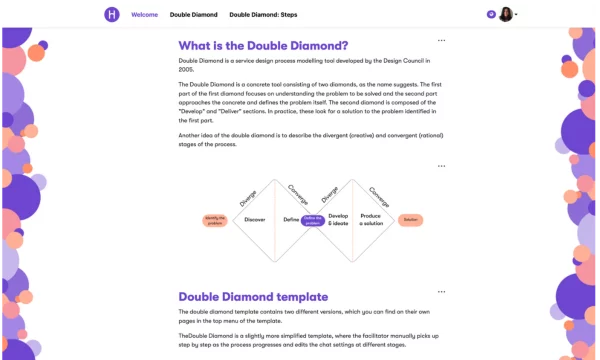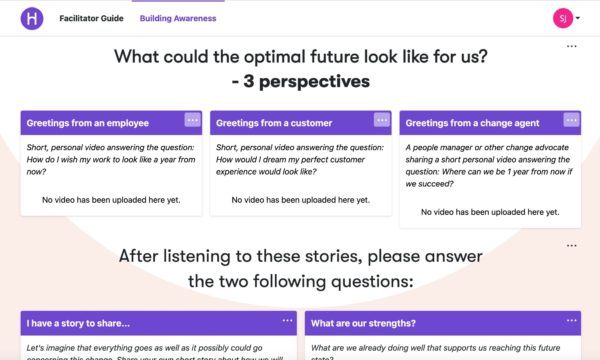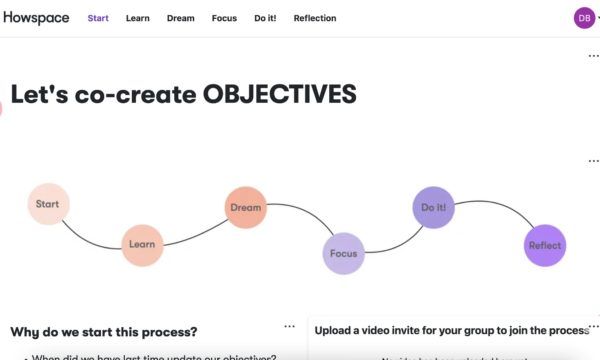
Navigating change: A guide to successful organizational transformation
Today’s business environment is affected by a number of factors. These include things such as technological advancements, internal challenges, and an increasing amount of competitors in the market. Many organizations are embarking on transformation efforts to either respond to the pressure or to stay ahead of the curve.
A recent report by McKinsey emphasizes that companies that meet their transformation implementation performance goals are highly likely to outperform industry averages in terms of financial growth. However, according to research, 70% of transformations fail, indicating that implementing successful transformation is not easy.
In this blog post, we’ll go through the steps an organization needs to take to succeed in its transformation journey.
Recognizing – Assessing the current state of the organization
The importance of understanding the current state of an organization before initiating any significant changes should not be underestimated. Rather than solely focusing on the desired future state, conducting a thorough assessment of the business is crucial to recognizing the need for change. According to a recent McKinsey Global Survey, this step is one of the most vital because it lays the foundation for successful transformation.
Conducting a thorough organizational analysis
A thorough analysis helps organizations understand their strengths and weaknesses, guiding leaders to identify areas that require change and areas where the organization already excels. Additionally, evaluating internal factors like culture, structure, and resources and external factors like market trends and competition is crucial for developing an effective transformation strategy. This understanding enables the organization to align its efforts accordingly.
Gathering data and insights through various methods
Gathering data and insights is a vital part of the assessment phase. Conducting interviews with employees, customers, and partners provides valuable perspectives, while surveys and feedback sessions shed light on diverse opinions and ideas. Additionally, reviewing performance metrics and financial data provides objective indicators of the organization’s current state.
By combining these methods, organizations gather comprehensive data to inform their decision-making during the transformation journey.
This thorough assessment lays the foundation for a successful organizational transformation, ensuring that the strategy is tailored to address the specific needs and challenges of the organization, ultimately driving positive change and growth.
Planning – Setting clear goals and objectives for the transformation
After assessing the organization’s current state, the next step is setting clear goals and objectives. This step involves defining the organization’s desired future state and identifying specific milestones that will lead to the successful implementation of the transformation.
Defining the desired future state of the organization
To begin, leaders must envision what the organization should look like at the end of the transformation journey. This requires understanding the desired outcomes, such as improved performance, increased innovation, agile and adaptive culture, increased employee engagement, etc. By visualizing this future state, leaders can effectively communicate the overarching purpose of the transformation to all relevant stakeholders.
Identifying specific goals and objectives to achieve the transformation
Next, goals and objectives are identified to support the transformation process. These goals should align with the organization’s mission and vision, ensuring that the transformation efforts align with the overall strategic direction. By ensuring this alignment, leaders can create a sense of purpose and motivation among employees, driving their commitment to the transformation process.
Establishing realistic and measurable targets
Establishing realistic and measurable targets that allow progress to be tracked and evaluated is essential. This involves breaking down the overall goals into smaller actionable KPIs (Key Performance Indicators) that can be achieved within specific timeframes. By setting realistic targets, the organization can maintain momentum and avoid unnecessary setbacks, while measurable KPIs clearly indicate progress and success.
Design – Developing a comprehensive transformation strategy
With clear goals and objectives in place, the next step in the organizational transformation journey is developing a strategy. The strategy serves as a roadmap that guides the organization through the transformation journey, ensuring a systematic and coordinated approach to achieving the desired outcomes.
Creating a roadmap and identifying key initiatives
Creating a roadmap involves outlining the necessary steps and initiatives to drive the transformation journey forward. This means identifying key projects, initiatives, and action steps contributing to the overall transformation goals.
Allocating necessary resources and budget
Allocating the necessary resources and budget is crucial to implement the transformation strategy successfully. This includes identifying the human resources, technology, and financial investments required to implement the change effectively. Adequate resource allocation ensures that the organization has the necessary capability and support to implement the transformation plan.
Defining timelines and milestones
Defining timelines and milestones is essential to track progress and maintain accountability throughout the transformation journey. By setting specific deadlines and milestones, the organization can monitor and evaluate the successful completion of key initiatives. This helps to keep the transformation efforts on track and ensures timely adjustments if necessary.
Addressing potential challenges and risks
Furthermore, it is important to address potential challenges and risks that may arise during the transformation journey. Anticipating and proactively managing these challenges allows leaders to develop contingency plans and mitigation strategies. This proactive approach enables the organization to navigate potential obstacles effectively and minimize any setbacks to the transformation efforts.
Implementation – Executing the transformation plan
Once the transformation strategy is in place, the focus shifts to implementing the plan and effectively managing change within the organization. This is important in turning the vision into reality and ensuring everyone is aligned and engaged throughout the transformation process.
Communicating the transformation vision to all stakeholders
Communication plays a pivotal role in successful implementation. Leaders must communicate the transformation vision effectively to all stakeholders, including employees, customers, partners, and shareholders. Transparent and regular communication helps create a shared understanding of the transformation’s goals, benefits, and progress. It also allows one to address concerns, manage expectations, and generate enthusiasm and support.
Engaging employees and building a culture of change
Employees should be involved and empowered to contribute their ideas, expertise, and feedback. Involvement fosters a sense of ownership and commitment to the transformation efforts. Leaders can establish cross-functional teams, hold regular town hall meetings, and provide training and development opportunities to ensure employees have the skills and knowledge required for the changes ahead.
Executing planned initiatives and monitoring progress
Action steps outlined in the transformation strategy should be implemented with precision and agility. Project management methodologies can be utilized to assign responsibilities, track progress, and ensure timely completion of deliverables. Regular monitoring and reporting of KPIs help to assess the progress and identify areas that require adjustments or additional support.
Providing support and resources for employees during the transition
During the transformation journey, providing support and resources to employees is essential. Change can be challenging, and individuals may experience resistance or uncertainty. Leaders should offer training programs, mentorship, and coaching to equip employees with the necessary skills and help them adapt to new working methods. Providing a supportive environment where employees feel heard and valued will help mitigate resistance and foster a smoother transition.
Optimization – Reviewing, evaluating, and improving
When transformation initiatives are implemented, it is important to evaluate and measure the success of the transformation to ensure that the desired outcomes are achieved. This evaluation phase involves defining success criteria and KPIs that align with the goals and objectives set during the planning stage.
Conducting regular evaluations and assessments
Regular evaluations and assessments are essential in monitoring the progress and effectiveness of the transformation efforts. By collecting data and analyzing the results, leaders can gain insights into the impact of the transformation on key metrics such as revenue growth, customer satisfaction, operational efficiency, and employee engagement.
Gathering feedback from employees and stakeholders
Feedback from stakeholders is a valuable component of the evaluation process. Their perspectives and experiences provide insights into the success of the transformation and highlight areas for further development. Surveys, focus groups, and one-on-one interviews can be conducted to capture their feedback and identify any gaps or challenges that must be addressed.
Analyzing both the quantitative data and qualitative feedback allows leaders to understand the overall impact of the transformation on the organization. It helps in assessing the effectiveness of the strategies implemented and identifying areas of success and potential areas of improvement.
Using learnings to improve
Lastly, learning from successes and failures encountered during the transformation process is important. Reflection on the lessons learned allows organizations to refine their approach and improve future transformations. By identifying best practices and challenges, leaders can continuously optimize their organizational transformation capabilities and drive more successful outcomes in future initiatives.
Collaborate, innovate, and drive meaningful change.
Organizational transformation is a complex and dynamic journey that requires careful planning, strategic implementation, and continuous evaluation. It is not a coincidence that organizations today are no more successful in achieving positive and lasting change than they were ten years ago. Failure to engage and involve employees seems to be a critical blind spot in many organizations.
Organizations undergoing a successful transformation share a common factor: widespread and meaningful employee engagement from the beginning of the journey to the end. However, building a transparent transformation journey where the right people can contribute at the right time is not an easy task to undertake, and therefore, it is not a surprise that so many organizations don’t succeed at their full potential. The purpose, vision, and direction should be set at the top of the transformation journey, but ultimately, the change is a more democratic process.
The right mindset, combined with the right tools, can help organizations unlock a successful human-centric transformation journey. Howspace connects people with transformation and helps leaders build an engaging and inclusive transformation journey where everyone is committed to driving positive change.
–
At best, organizational transformation is a strong force that shapes your business for the better. Howspace can support you in unlocking the full potential of your organization by putting people at the heart of transformation.
If you want to learn more about our human-centric approach to transformation and hear from speakers from KONE, Wärtsilä Energy, SAP, Sofigate, Gaia Consulting, and other industry experts and thought leaders, catch our Transformative Impact 2023 event recording.
You might be interested in these as well
View all
Emotional Leadership in Change and Transformations at Different Organizational Levels
Discover the power of emotional leadership in navigating change at different organizational levels.

Gofore joins forces with Howspace as a new strategic partner
Gofore joins forces with Howspace as a new strategic partner to drive human-centric digital transformation.

Make Your Decision-Making More Inclusive and Effective
Participatory decision-making taps into the collective wisdom of your entire workforce. Here’s how to make more impactful decisions in your organization.
Templates related to this topic
View all
Double Diamond

ADKAR: Awareness Stage
